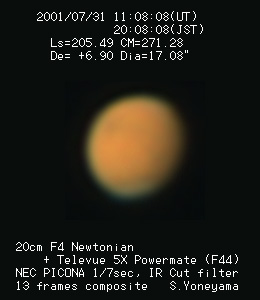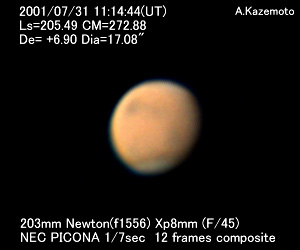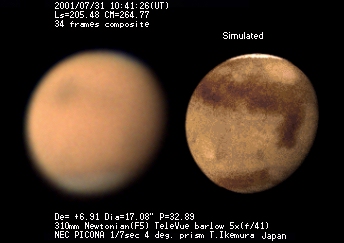火星 月惑星研究会 関西支部 (最新)
ALPO-Japan LatestMars Image 2001/07/31
米山誠一,風本明,池村俊彦,Ed Grafton,新川勝仁,Mars Orbiter Camera
S.Yoneyama,A.Kazemoto,T.Ikemura,E.Grafton,M.Niikawa,MOC
解説(安達)

Used our web and International Mars Watch.
ダストストームの淡くなってきた部分が、北極地方だけではなく3ヶ所見られましたシルチス(Syrtis Major;290°、+10°)の先端とチュレニー(Mare Tyrrhnum;260°、-10°)付近と、キンメリウム(Mare Cimmerium;230°、-20°)付近です。これら3ヶ所はいずれも高度の高い土地に相当します。今まで、ダストストームが覆っていたところがこのように淡くなるということは、この地方では少なくともダストストームがすいたい傾向にあることを示しています。
ただ、今回注目されるのは、シルチスのすぐ北東部分にダストの明るい光斑が出現していることです。これが再び大きな大気の撹乱を起こす可能性もあり、注意が必要です。
Ed Grafton氏の画像によれば、ソリス(Solis lacus;90°、-25°)付近に明るいダストストームを記録されています。この部分は、7月中ごろに観測されていた明るいダストストームがそのまま残ったものかあるいは、新しいものかははっきりしません。また、Ed Grafton氏の画像ではタルシス(Tharsis;120°、-10°)近辺の3つの山も暗斑にとらえられており、この部分ではダストストームが全体的に広く低くなってきていることを感じさせています。
Explanations M.Adachi
There are 3 faint dark places on Martian surface. 1st is top of the Syrtis Major. 2nd place is Mare Tyrrhenum.3rd place is Mare Cimmerium.
These are high land in any way. It seems that the dust storm declined on these region.
The bright dust storm spot appeared on Solis Lacus region.This is a clearly seen by Ed Grafton's image. Ed Grafton catched clearly Tharsis Monses.
| Seiichi Yoneyama(200mm F4 Newton, Digital still camera NEC PICONA) |

Seeing:3/5 Transp.:2/5
曇りの日とシーイングが極端に悪い日が続き、半月ぶりにまともな画像が得られました。今日は曇る直前に何とか20コマ撮影できました。
火星面の模様が薄っすらと見えています。砂嵐が収まり始めたのでしょうか。北極の雲と南極冠も見えています。
≪神奈川県横浜市 米山誠一≫
| Akira Kazemoto(203mm Newton, Digital still camera NEC PICONA) |

シーイング 5/10。
キムメリウム、ヘスペリア、シルチス北部、
アエテリアなどが見えている。
≪京都府久世郡 風本明≫
| Toshihiko Ikemura (310mm Newton, Digital still camera NEC PICONA) |
 seeing 6/10
seeing 6/10≪愛知県名古屋市 池村俊彦≫
| Ed Grafton( ST6 CCD 14 inch f/11 Celestron SCT) |

Eyepiece Projection @ f/60 Seeing good 7/10, transparency excellent 9/10, wind South at 5 MPH, nodew. [Ed Grafton, Houston Texas]
| Masahito Niikawa (280mm SC, Digital still camera Minolta DimageEx1500) |

Mars on Jul.31, 2001 Ls = 205.5, De = +6.9, Dia = 17.1" [IR1] 2001/07/31 13:20:56 (UT) CM = 303.6 16 frames composite [B1] 2001/07/31 13:31:58 (UT) CM = 306.3 25 frames composite [R1] 2001/07/31 13:48:00 (UT) CM = 310.2 32 frames composite Observer:Masahito Niikawa Email:zba03198@bird.zero.ad.jp Obs.site : Mozuhonmachi Sakai-City Osaka Japan Telescope : C11 (SC) D=280mm fl=2800mm Camera:Minolta DimageEx1500 Digital Camera taking lens removed CCD:ICX205AL (Sony Monochrome CCD) Blue Images indicate [B] Filter: B390 (360nm - 500nm) Exposure :1/3 sec Effective F No.: 36 (XP24mm Eyepiece Projection) Near IR Images: indicate [R] Filter: R64 (640nm - 1000nm) Exposure : 1/30 sec Effective F No.: 36 (XP24mm Eyepiece Projection) IR image indicate [IR] Filter: IR84 (840nm - 1000nm) Exposure :1/3 sec Effective F No.: 36 (XP24mm Eyepiece Projection) Seeing = 7/10 Transparency = 2/6 Image Processing; Enhanced with unsharp masking method. Caption: Hellespontus, Pandorae Fretum, Sinus Sabaeus are noted dark through the dust cloud. 説明: Hellespontus, Pandorae Fretum, Sinus Sabaeusがダスト雲を 通して暗く見える。 ≪大阪府 堺市 新川勝仁≫
| ||
South up South up
 Original image1380X1380 tif 4010kB
Original image1380X1380 tif 4010kB 
South up South up
 Original image2048X1536 jpg 1176kB
Original image2048X1536 jpg 1176kB 
 ALPO-Japan Latest
ALPO-Japan Latest  Mars Section
Mars Section